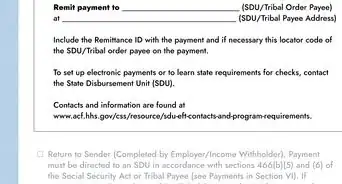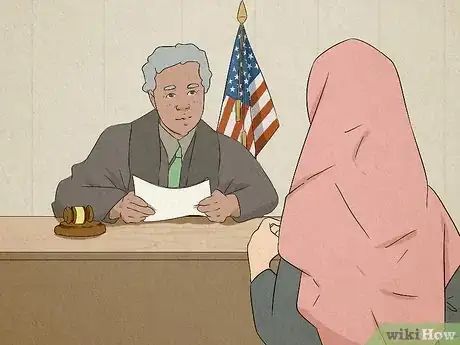This article was co-authored by wikiHow staff writer, Eric McClure. Eric McClure is an editing fellow at wikiHow where he has been editing, researching, and creating content since 2019. A former educator and poet, his work has appeared in Carcinogenic Poetry, Shot Glass Journal, Prairie Margins, and The Rusty Nail. His digital chapbook, The Internet, was also published in TL;DR Magazine. He was the winner of the Paul Carroll award for outstanding achievement in creative writing in 2014, and he was a featured reader at the Poetry Foundation’s Open Door Reading Series in 2015. Eric holds a BA in English from the University of Illinois at Chicago, and an MEd in secondary education from DePaul University.
There are 14 references cited in this article, which can be found at the bottom of the page.
This article has been viewed 26,690 times.
Learn more...
If you want to increase or decrease your child support payments, adjust your visitation rights, or change your custody status, you’ll need to file a child support modification application to see a judge. Winning that modification case can be tough depending on what you’re trying to change (and why), but there are a variety of ways to improve your chances. If you want some tips, we’ll walk you through everything you can do to push the odds in your favor. Keep in mind, every state has unique requirements and guidelines when it comes to child support modification, so while the overall process is universal, make sure that you follow your state’s requirements to avoid having your case dismissed. There may also be things you aren’t legally allowed to change, depending on where you live.
Steps
Take advantage of the rights you already have.
-
This shows the judge you’re responsible and engaged with your child. A judge won’t be inclined to modify a court order in your favor if you aren’t following the court’s current orders or utilizing your rights. On top of that, it’s important to show that you can (and want to be) doing everything you can to benefit your child. If you’re coming up short, take the steps you need to fix that as soon as you can.[1] X Research source This includes issues you have with:
- Skipping out on your days when you’re supposed to take your children.
- Eschewing child support payments when you have the ability to pay them.
- Dropping your children off unexpectedly when you’re the custodial parent.
- Refusing to abide with other court orders (like probation, or therapy).
Reach out to your ex-partner if you think they’ll be amicable.
-
If you and your ex have a good rapport, consider starting with them. There are typically two ways to justify a modification—either you win in court or you come to an agreement without a judge. If you can come to an agreement, it’ll be easier for everyone. You’ll still need to file a modification with the courts, but if you and your ex can agree on a change without a judge, you’ll just be able to sign a form together and file it at the court to change the terms of your child support.[2] X Research source
- This is really only a good idea if you are on good terms with your ex and your request is reasonable.
- An agreed-upon change is referred to as an “uncontested” modification. Neither you nor your ex-partner will need to appear in front of a judge to make one of these changes.[3] X Research source
Solicit free legal help if you can’t hire an attorney.
-
Unfortunately, it’s a lot harder to win a modification case without legal help. If you have a divorce attorney, set up a meeting with them and explain what you want to change in your agreement.[4] X Research source If you can’t afford a lawyer, at least look for free legal assistance with the application. You’d be surprised how many free legal resources there are. You may qualify for a “lawyer for the day” at your local courthouse. These are pro-bono lawyers who offer help filing documents at the courthouse.[5] X Research source
- You can also contact the Department of Revenue Child Support Enforcement Division where you live to ask questions. They’ll typically walk you through any sections on the application.[6] X Research source
- There are often pro-bono law offices that will offer help with applications to modify child support.[7] X Trustworthy Source United States Department of Justice Official website of the U.S. Department of Justice Go to source
- A lawyer will be able to spot clerical errors or mistakes on your application to modify your child support, which can cause it to be thrown out by a judge.
Do it on your own only if you can’t get help.
-
Submit a modification application on your own if you can’t get help. Contact your local family court and request an application to modify an existing child support order. They’ll provide you with the applications, affidavits, and forms that you’ll need to fill out and file in order to petition the court for a change.[8] X Research source
- You can normally print these forms at home and then file them at the courthouse, but you may be able to do it online depending on where you live.
- In some states, your application can be reviewed by a judge without you or your ex-partner being there. In some states though, you have to see a judge in-person. Once you file, wait to hear from the court regarding where you’ll need to show up and when.[9] X Research source
Determine what has changed to justify a modification.
-
You must meet your state and county’s criteria to justify a change. If you and your ex-partner do not come to an agreement outside of the court, you can only win your modification case if you meet the standards for a change where you live. Your lawyer will be able to help you determine if you meet the local requirements. Common reasons to justify a change include:[10] X Research source
- A dramatic increase or decrease in income.
- Extraordinary medical expenses or legal fees.
- An increase or decrease in expenses for your child.
- Your child turns 18, or you get back together with your ex.
- A major life event that dramatically changes your circumstances.
Rely on external justifications if nothing has changed.
-
If your personal circumstances haven’t changed, point to external issues. If you haven’t experienced a major life change, you can point towards a broader issue that may be influencing something like your child support or visitation rights. Economic trends, regional concerns, or cultural trends may be able to sway a judge to modify how much you pay in child support or how often you get your children.[11] X Research source For example, you could make the following arguments:
- Inflation is causing the buying power of the dollar to decrease, but your wages haven’t increased alongside inflation.
- The cost of goods is increasing, and you’re unable to pay the current child support costs without being evicted.
- Your ex-partner has moved closer to where you live, so you should pay less in child support since you can help out in more material ways.
- Our culture has changed, and there’s enough research to indicate that children suffer more from not spending an equal amount of time with both parents.
Document that change to obtain proof.
-
Work with your lawyer to determine what you’ll need to provide. You usually need to document any justification for a modification. If you just lost your job, you may need a letter from your previous employer, bank statements demonstrating the loss of income, and evidence that you’ve applied to other jobs and been turned down.[12] X Research source
- There are typically separate court forms that go along with your application for a modification. You may need to file these forms alongside the application, or present them at court to the judge depending on where you live.
Explain how your proposed modification benefits the child.
-
You may need to include this on the application, or explain it in court. Regardless, determine how your proposed change to the child support benefits your child. A change on its own is typically not enough to justify a change to child support, so work with your lawyer to develop a compelling reason why your proposed change is good for your child.[13] X Research source For example:
- If your hours are cut at work, you could argue that it’s a good reason for you to get your child more often, since you’ll have more free time to spend with them.
- If you incur a big hospital bill, you could argue that your child support payments should be paused, since it won’t be good for your child to have an unhealthy or disabled parent who needs to pay for treatment.
- If you finally get a job after months of looking, you could argue that you deserve joint-custody, since you’re able to afford everything your child needs in your home.
- This is why it’s so hard to reduce child support payments. It’s very difficult to justify you paying less for your child’s care—even if you lose your job and it becomes harder to keep up. In the meantime, continue to pay as much as you can towards the balance.[14] X Research source
File the proposal and submit a copy to your ex-partner.
-
Once you’ve filed the applications, submit a copy to your ex and their lawyer. How you complete this step depends on where you live, but start by going to the court. Find the court assistance office and ask them what you need to do to fully submit your request. The court may have you mail copies of the forms out, or they may notify them on your behalf. Depending on where you live, you may serve them yourself.[15] X Research source
- Most city and county courts have a court assistance office, but you may need to reach out to the state attorney general if they don’t. You can typically find this process explained step-by-step on your county or state’s family courts page.[16] X Research source
Wait for a response from the court or your lawyer.
-
If the modification is contested, you’ll receive a court date in the mail. So long as your application was filled out correctly and your justification for the change is sound, you have done everything in your power to put the odds in your favor up to this point. Contact your lawyer as soon as you get this court date and time in the mail so that they’re able to join you.[17] X Research source
- If you don’t have a lawyer, now is the time to reach out to a pro-bono family court organization. Unlike criminal cases, you will not be able to utilize a public defender for a child custody case, and it will really help your odds if you have a lawyer on your side for this.
- In most states, your ex will have a period of time (usually 21 days) to respond to the request for a modification. If they don’t respond, a judge may automatically rule in your favor and you may not need to go to court.
Show up to court on time.
-
Your first impression with the judge is key, so dress well and be punctual. Iron your suit or dress ahead of time, and do your hair. Show up to the courthouse a little early so that you have time to find the courtroom, use the bathroom, and compose yourself. This way, you can walk into the courtroom looking comfortable, clean, and well-groomed with a smile on your face.[18] X Research source
- This way, you’ll look and feel your best when it’s time for you and your ex to step out in front of the judge.
- From this point on, all you can do is plead your case and hope for the best. You’ve done everything you should do up to this moment, so don’t be too hard on yourself if it doesn’t go your way. It’s in the judge’s hands now.
Answer the judge’s questions and stay calm.
-
You and your ex will both have a chance to speak, so be kind and professional. As tempting as it may be to start rattling off everything your ex does wrong, it won’t come off the right way. Let your lawyer do the talking for you until the judge calls on you specifically. The judge will review the documents, and they may ask you questions about motivation for the modification, or to expand on something in your application. Regardless, be friendly, professional, and honest in your answers.[19] X Research source
- You’re the one who wants something changed, so it’s going to be on you to demonstrate why it’s a good idea.[20] X Research source
- Your lawyer may be able to plead your case on your behalf, but the judge may still call on you to explain.
- You might say something like, “Your honor, I have incurred a series of medical expenses that make it impossible for me to keep up with current child support payments. I do want to pay to support my child, but I don’t think it will benefit them if their father/mother is too sick to pick them up or care for them. This is why I’m requesting a temporary suspension to my child support payments.”
Demonstrate a willingness to compromise in front of the judge.
-
The judge may propose a middle ground, so lean into it if they do. The judge has the control here, and every family court judge in the country likes it when parents act like adults. If they recommend a change and they want to know if you’re open to it, agree (so long as it’s a reasonable compromise). If your ex is the one who bucks back, you’re likely going to get what you want.[21] X Research source
- For example, if you’re seeking a $300 deduction in monthly child support and the judge asks if you’d be okay with $150, agree if you can. If you can’t, say something like, “I’d love to your honor, I really would. Unfortunately, my hours have been cut at work and I’m unable to pay my rent and child support without at least a $200 deduction.”
Abide by the court’s decision.
-
It may hurt if you don’t win, but you have to listen to the judge. If you get your child support modification approved, great! If you don’t though, do your best to move on. Judges don’t always get it perfect, and you can always give it another shot in the future. It can hurt to come out of a child support hearing not getting what you want, but ignoring the judge will cause more problems than it’s worth.[22] X Research source
- You can try reaching out to your ex after the modification hearing is over to see if they’d be willing to sit down and come to an alternative modification. If they are, you’ll be able to file an uncontested modification.
- You can always try again whenever your next major life change occurs. Try not to get too down about it.
You Might Also Like












References
- ↑ https://www.louisianafamilyandelderlaw.com/5-essential-tips-for-winning-child-custody-louisiana/
- ↑ https://courts.alaska.gov/shc/family/shcmodify.htm
- ↑ https://texaslawhelp.org/article/changing-a-custody-visitation-or-child-support-order
- ↑ https://courtselfhelp.idaho.gov/docs/forms/CAO_M_Instr_1.pdf
- ↑ https://www.masslegalhelp.org/children-and-families/child-support-change-how#lawyer-for-day
- ↑ https://www.masslegalhelp.org/children-and-families/child-support-change-how
- ↑ https://www.justice.gov/eoir/list-pro-bono-legal-service-providers
- ↑ https://courtselfhelp.idaho.gov/docs/forms/CAO_M_Instr_1.pdf
- ↑ https://texaslawhelp.org/article/changing-a-custody-visitation-or-child-support-order
- ↑ https://www.montcopa.org/542/Modifying-Changing-a-Support-Order
- ↑ https://www.divorcenet.com/states/new_jersey/modification_support_orders_in_nj
- ↑ https://www1.nyc.gov/assets/hra/downloads/pdf/services/child_support/noncustodial_parents.pdf
- ↑ https://courtselfhelp.idaho.gov/docs/forms/CAO_M_Instr_1.pdf
- ↑ https://www.texasattorneygeneral.gov/child-support/paying-and-receiving-child-support/get-back-track/modify-child-support
- ↑ https://www.montcopa.org/DocumentCenter/View/24937/Petition-for-Modification-of-an-Existing-Support-Order
- ↑ https://courtselfhelp.idaho.gov/docs/forms/CAO_M_Instr_1.pdf
- ↑ https://courtselfhelp.idaho.gov/docs/forms/CAO_M_Instr_1.pdf
- ↑ https://www.louisianafamilyandelderlaw.com/5-essential-tips-for-winning-child-custody-louisiana/
- ↑ https://texaslawhelp.org/article/tips-for-the-courtroom
- ↑ https://www.wagner-law.com/child-support-modification-hearing/
- ↑ https://www.louisianafamilyandelderlaw.com/5-essential-tips-for-winning-child-custody-louisiana/
- ↑ https://courtselfhelp.idaho.gov/docs/forms/CAO_M_Instr_1.pdf
About This Article



























































